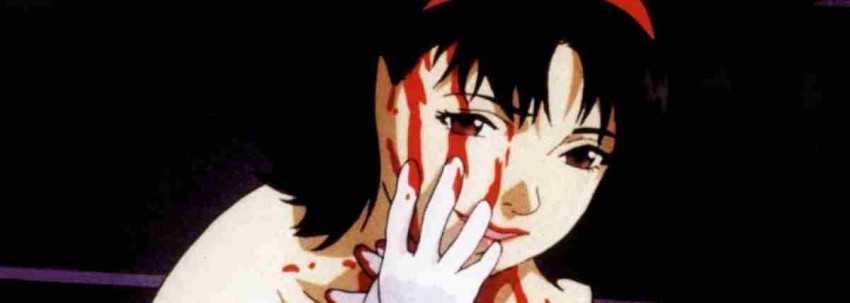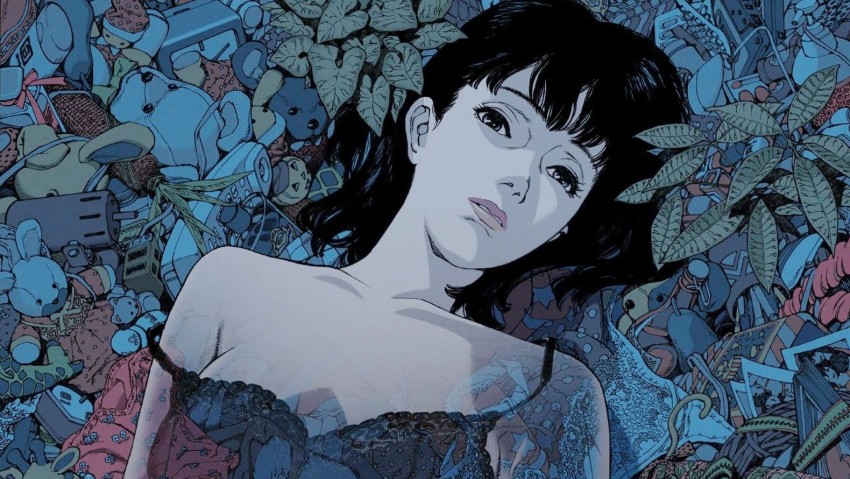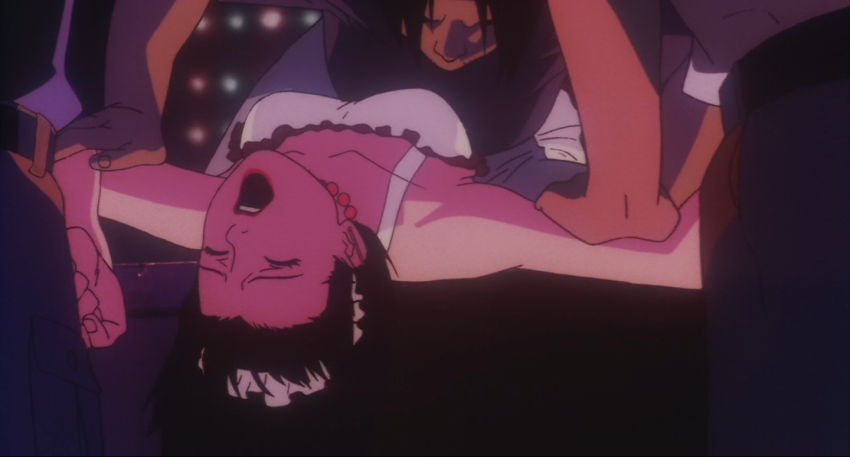Interview: Satoshi Kon
November 26, 2017 · 3 comments
 Minor-league pop idol Mima ditches her girl group to become a solo artist and serious actress. When her managers push her towards sleazy “grown-up” roles, one self-styled avid fan exacts deadly retribution for the loss of her schoolgirl image, in a tense drama of suspense and murder.
Minor-league pop idol Mima ditches her girl group to become a solo artist and serious actress. When her managers push her towards sleazy “grown-up” roles, one self-styled avid fan exacts deadly retribution for the loss of her schoolgirl image, in a tense drama of suspense and murder.
A fierce spotlight turned on the world of stardom, Perfect Blue is a study in madness and psychological horror, based on the chilling novel by Yoshikazu Takeuchi. Gritty direction from the late Satoshi Kon (Memories) combines with a script from Sadayuki Murai (Steamboy) for a thriller to rival Hitchcock and Argento. Since its original release in 1997, the movie has become a cultural icon in its own right, referenced everywhere from Madonna’s Drowned World Tour to Darren Aronofsky’s Requiem for a Dream and Black Swan.
To mark Perfect Blue’s re-issue this year from Anime Limited, this website is proud to run Andrew Osmond’s interview with director Satoshi Kon, originally conducted around the time of the film’s cinema release.
Andrew Osmond: What is the significance of the title Perfect Blue?
Satoshi Kon: That’s a frequently asked question and, at the same time, one I find very difficult to answer. To be honest, I used it because it was the title of the original novel [Perfect Blue: Total Pervert by Yoshikazu Takeuchi, published in 1991]. I presume the words had some significance, but as I changed the story and probably the subject as well, I guess the meaning was lost. I can only guess because I didn’t read the novel. I simply read through the rough plot, which was described as “close to the original story” in the project plan delivered to me. We discussed changing the title, but I like it, it sounds significant and mysterious.
If you had to categorise your film, would you call it a thriller, a horror film or a supernatural film? Or do you think it’s outside such categories?
I cannot find a reason to categorise the film, but the advertising copy called it “psycho horror.” If pressed, I would call it “psycho suspense.” The film focuses on the process by which the victim’s psyche is destroyed, rather than how insane the suspect is.
Many viewers have found it difficult to figure out which of the later scenes are “real” and which takes place in Mima’s head, or maybe someone else’s head. Is it possible to work it out through repeated viewing?
It’s the difficulty of figuring it out that is at the core of the film. If you saw the film many times in order to distinguish between objective reality and the main character’s subjective experience, I think the film’s flavour would disappear. So long as you accept that it’s meant to be inexplicable, that’s fine.
 Is there a totally natural explanation for everything that happens in the film?
Is there a totally natural explanation for everything that happens in the film?
I don’t know what you mean by “natural” but there’s a natural explanation for me as creator since I distinguished between subjective and objective while making the storyboards. However, some scenes lead from sequences of reality to illusion, so I guess it is hard for the audience to tell which is which. However, as I said, it is not the object of the film to distinguish them.
One of Perfect Blue’s themes is the conflict between Mima’s public image as an idol singer, and the person she really is. Do you think the problem is equally true of all people in the public domain: actors, politicians, even famous manga writers?
I think it is a problem everybody has, male or female, famous or anonymous. I mean, there’s a gap between the image people see of me and what I see myself. Perfect Blue is about the tragedy caused by that gap becoming too large.
Could you have told a similar story with a male celebrity?
I think so. Especially in the current Japanese climate, a story featuring a male celebrity would be more convincing. However, taking the Japanese animation audience into consideration, I think it’s more easily acceptable to feature a young, cute girl as the main character.
Uchida, the stalker, is very disturbing. Do you think many real-life fans take their obsessions to unhealthy level?
It could be possible, but I don’t think it’s likely. Most stalking cases feature a victim personally known by the stalker. I believe everybody has the capacity for insane behaviour, but these stalkers sharpen their obsession to obtain ideas which other people are not able to understand, and act accordingly. It wasn’t the film’s aim to explain the process and structure of the stalker’s mind. Rather, I depicted a perverse man like Uchida as completely inexplicable. Insane people are insane because the normal can’t understand them. If I had made Uchida explicable for everybody, I don’t think we could have called him insane any longer.
Were you influenced by events such as the Tsutomu Miyazaki murders and the Aum cult atrocities, both of which were linked in the Japanese press to the otaku (obsessed fan) phenomenon?
I don’t think there’s any direct influence. There are similar crimes in this film, but I didn’t focus on the crimes themselves but on the person at their centre, Mima.
 What is your attitude towards movie violence? For example, Mima consents to do a rape scene for the “Double Bind” TV show. Do you think she is right to do this, no matter what other characters in the film think?
What is your attitude towards movie violence? For example, Mima consents to do a rape scene for the “Double Bind” TV show. Do you think she is right to do this, no matter what other characters in the film think?
I think Mima’s decision about the rape scene in “Double Bind” is right. I don’t think it’s anything to do with movie violence. Her decision is just part of her quest to overcome all the hurdles to be a professional actress. As an adult, we face many hard trials to be approved as an individual. I regard the rape scene as an extreme trial.
How have audiences responded to your film so far? Did you mean Perfect Blue to appeal to a particular kind of viewer?
Most audiences seem to give it a thumbs-up. Those who tried to fit it into a familiar category regard it as strange. I didn’t mean to appeal any particular kind of viewer. I always create what I want to see.
Perfect Blue uses a lot of deliberately disorienting jump cuts, such as switching between Mima in concert and Mima’s “real” life at the beginning of the film. You’ve mentioned Kurt Vonnegut’s Slaughterhouse 5 as an inspiration. Did you mean the book or the film [directed by George Roy Hill in 1972]?
Both were excellent pieces of work, very interesting. Regarding their influence on Perfect Blue, it was probably in the film technique. The human brain is mysterious. We can’t share the time axis in our memory with others. For example, when we remember an impressive event that happened twenty years ago, the memory may follow something that happened yesterday. I think everyone has that experience. Regarding the opening scene, I wanted to express that for Mima, her stage job is juxtaposed with ordinary life. For her, public and private are indivisible. She’s not able to differentiate between them as a member of society.
You’ve also cited the fantasy director Terry Gilliam as an influence. [In the Perfect Blue press notes, Kon said of Gilliam, “Despite being fantasy, his depictions are quite bitter, his narration also throws curve balls, and rather than covering every point in detail, he takes the staging off to a completely different point and plucks out a single vivid theme.”] What in particular appealed to you about him?
I like Gilliam’s pieces, especially Time Bandits, Brazil and The Adventures of Baron Munchausen. They’re all excellent films which mix dream and reality. The brilliant thing about Gilliam’s work is his bitter criticism of inert and stagnant societies, such as our own, as well as his childlike imagination and creativity.
Perfect Blue has been compared to a range of other films, including Dario Argento’s Suspiria (1977) and various Alfred Hitchcock movies. Have you seen any of these, and did they influence you?
I haven’t seen any Argento films until after his name was mentioned several times at interviews. I saw two pieces after completing Perfect Blue. Argento’s The Stendahl Syndrome (1996) was very interesting, about a victim chasing a madman while at the same time the victim’s psyche is being destroyed. I’ve seen Hitchcock movies as a matter of course, but I don’t think I was directly influenced by them. I’m interested in how the audience judges.
You’ve said you wanted to break away from anime clichés like giant robots and “beautiful little girls.” Do you think anime will evolve away from these things in the next few years? Or will these formulae be used again and again?
Basically, I don’t the animation market will change. Animation based on popular comic books and giant robots and big-eyed girls with shamefully skimpy costumes will continue to fill the screen. I think that’s okay. These productions fill a demand: the audiences for them support the Japanese animation industry. Thanks to them, there is room for a non-mainstream creator like me. Of course, I hope many unusual pieces will appear as well.
Perfect Blue is released on UK Blu-ray by Anime Limited.
Lena
January 5, 2023 10:19 am
Does anyone know the exact date of this interview, please? Thank you in advance!
Andrew Osmond
January 5, 2023 11:17 am
Hello, it was originally published in the American print magazine Animerica in July 1999, Vol 7, no 6.
Lena
January 13, 2023 3:39 pm
Sorry for the late reply! Thank you so much! I was in need for that information for a written article for college. :) Thank you so much once again! :D Cheers!